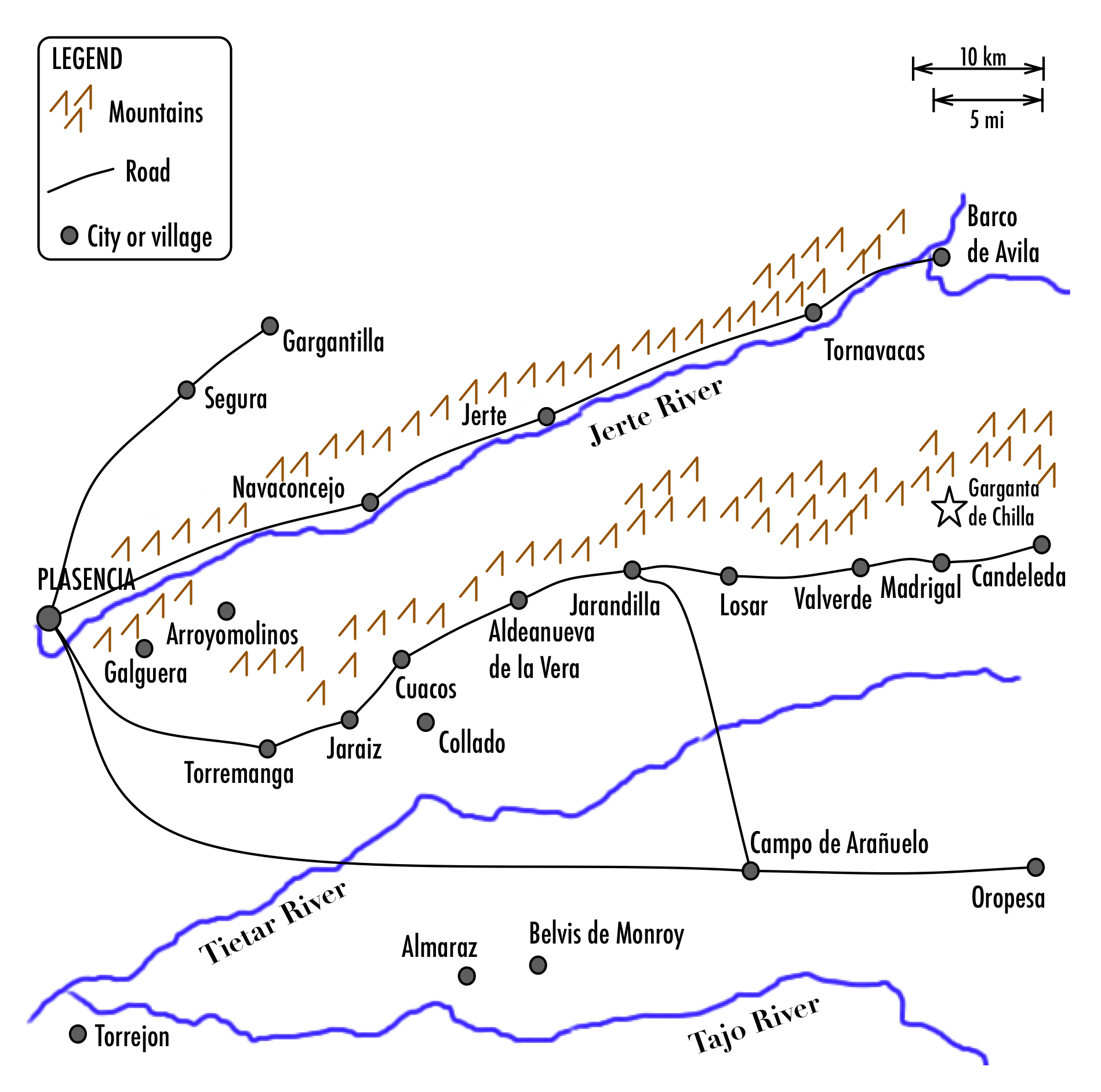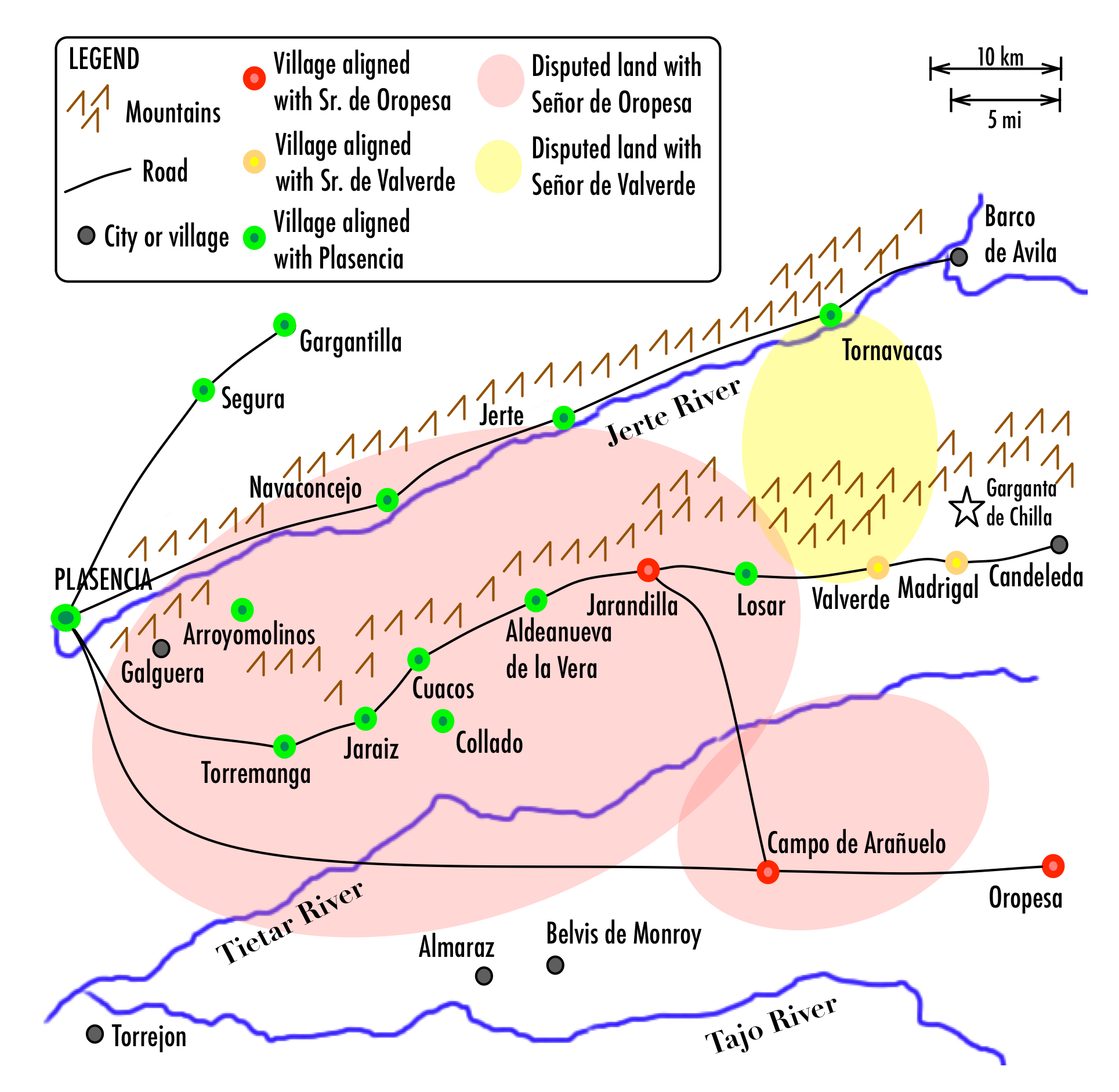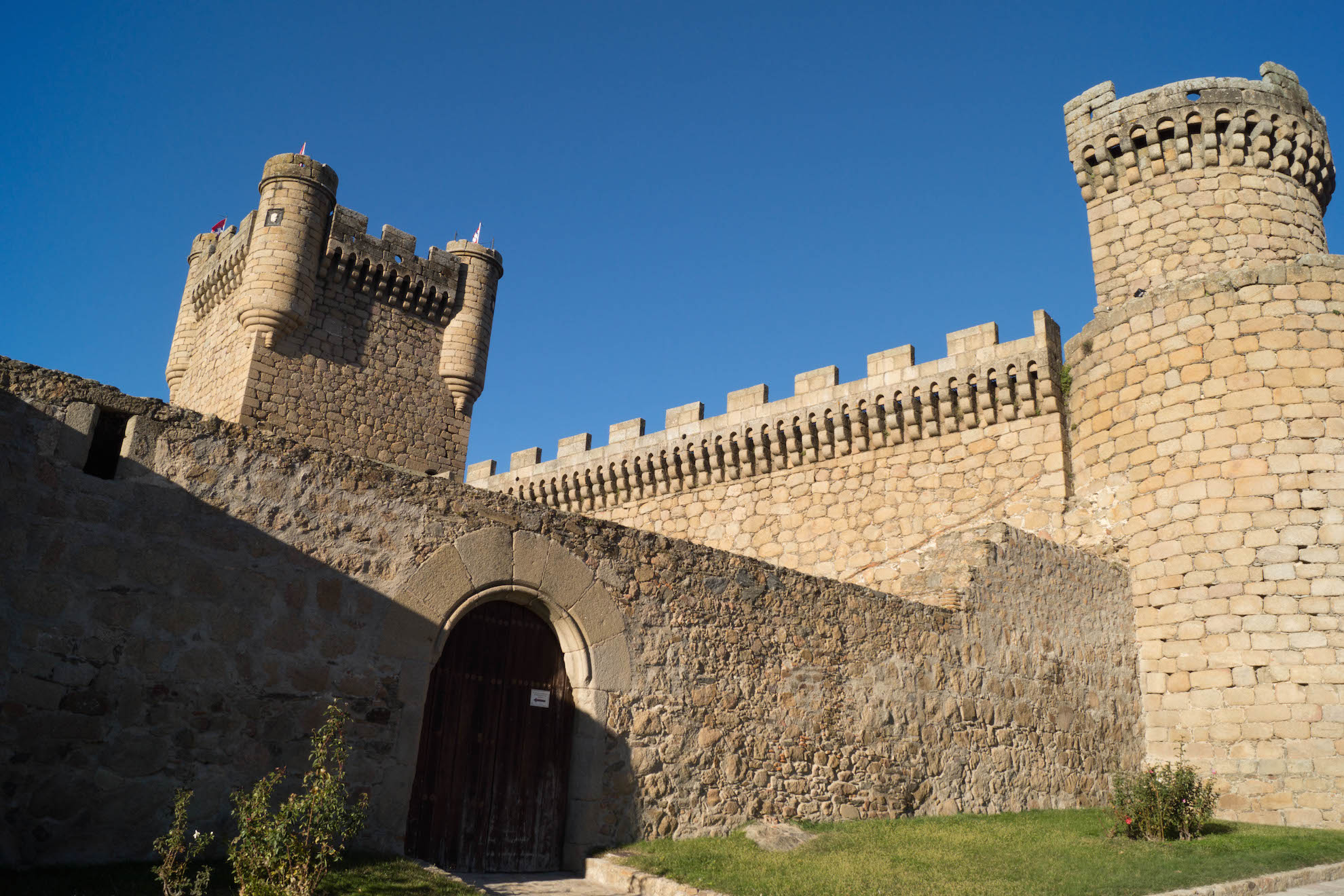“The Bodies of Fartalo and His Wife”: Open War Among Christians. Jews Caught in the Middle, Circa 1431
by Dr. Roger Louis Martinez-Davila.
[/lab_heading]
During this era, it appears that the city council and the Cathedral of Plasencia served as the de facto local authorities for resolving secular conflicts in the northeastern section of the Diocese of Plasencia. However, during the 1420s these instruments of power were insufficient to compel local lords like the Señor de Oropesa and Señor de Valverde to comply with the will of either governing institution. As evidence for this argument, in 1431 King Juan II dispatched Judge Miguel Sánchez de Sepúlveda to the city to investigate disputes over jurisdiction and property, as well as review multiple claims of improper imprisonments and the deaths of two Placentino Jews.[1] Tragically, Christian commoners and Placentino Jews became unwilling pawns in this regional quarrel over communal access and rights to lands near the village of Jarandilla de la Vera (referred to as Jarandilla), which is located east of Plasencia. (See Figure 1.)[/lab_scroll_box]

Figure 1: The Geographical Focus of the 1431 Royal Investigation. Map by Roger L. Martinez-Davila.
Also gathered for the hearings, which were held in the Church of St. Vincent, were residents from the neighboring communities of Losar, Arroyo Molinos, Jarahiz, Cuacos, Aldeanueva de la Vera, Jerete, Navaconcejo, Ojalvo, Esperilla, Gargantilla, Segura, and Tornavacas.[4] Notably absent from the meeting were García Álvarez de Toledo (theSeñor de Oropesa) and Pedro Niño (the Señor de Valverde) whose own interests ran counter to those from Plasencia and most other local communities. In particular, theSeñor de Oropesa and the Señor de Valverde were particularly power as they ruled their sub-regions of the Extremadura as the ultimately secular authorities. In essence, if they could extend their political authority to new lands, and at the expense of the City and Cathedral of Plasencia, then they could benefit in the form of collecting additional taxes.[/lab_scroll_box]
Indeed, in the years prior to the inquest, there was a significant increase in violence against persons and property in the kingdom as a result of convoluted property and jurisdictional conflicts involving the monarch, noble families, and churches.[7] It is telling, for example, that three of the ascending members of the Carvajal clan received papal absolutions for their participation in violent clashes in the village of Trujillo and the surrounding region. In 1427, the Holy See granted Rodrigo de Carvajal, who would become the Archdeacon of Plasencia and Béjar in the 1440s, and his cousin, Alvaro, “absolution of censure for…their armed intervention” in a conflict that left many persons in the village of Trujillo injured or dead.[8] Two years later (March 1429), the pope granted Juan de Carvajal, the brother of Rodrigo and the future Bishop of Plasencia, a more extensive papal dispensation for his participation in a “quarrel that resulted in bloodshed.”[9] Juan’s crimes were so problematic to his advancement in the church that Pope Martín V absolved the churchman of “all irregularities and infamy” that would prevent him from acquiring a religious benefice. Five months after receiving his papal dispensation Juan was able to assume a canon’s position in the Cathedral of Palencia, which is located to the northeast of Plasencia.[10] Thus, it appears that the ecclesiastical relief that Juan and his brothers sought from the Roman Catholic Church was not linked to an isolated affair, but rather multiple regional disagreements, which ultimately required the intervention of an outside royal judge.
In a 1431 letter that accompanied Judge Miguel Sánchez on his journey to Plasencia, King Juan II endowed the judge with broad and comprehensive authority to review the discord in the Diocese of Plasencia. The king stated:
I have placed my trust in Miguel Sánchez de Sepúlveda, Bachiller of Law…to conduct an investigation regarding any items—all of them—including…pleas, …allegations …and thefts. And for half a year Miguel Sánchez can suspend the offices and powers of my local mayors and judges [to pursue this investigation].[11]
Thus, the king’s decision to grant the judge this breadth of power reveals that local noble families lacked sufficient political sway to resolve these regional conflicts and enforce peace in the greater diocese. It further suggests that King Juan II believed he needed to subjugate all local secular powers in the region to his supreme authority. Only in this manner could the judge resolve the conflicts. This circumstance was almost certainly due to the nature of Castile’s overlapping secular and ecclesiastical jurisdictions. Because the Señor de Oropesa and Señor de Valverde were the king’s vassals, only the monarch could hold them to account in secular affairs. These señoreshad explicitly demonstrated through their actions that they believed the city council of Plasencia lacked any authority to impose its decisions and mandates on territories considered outside its periphery (termino). In particular, the Señor de Oropesa appeared willing to test the limits of his jurisdictional authority outside of the villages of Jarandilla and Tornavacas. A critical focus of the judge’s investigation and findings would center on the extent of Plasencia’s periphery, particularly the area to the east of the city.
As all of the claimants framed the conflict as a secular matter, and not as a church issue, the local church leaders were unable to harness the authority of the cathedral of Plasencia to resolve the matter in their favor. If the issue were ecclesiastical in nature, then Bishop Santa María and the cathedral’s church chapter could claim jurisdiction over all lands west of the Cathedral of Ávila and the Monastery of Guadalupe. However, the jurisdictional conflict did not pertain to church properties or the payment of church taxes and therefore the local Carvajal-Santa María family confederation could not exercise the church’s power in the matter. Thus, to ensure that Judge Miguel Sánchez had sufficient authority to enforce an agreement among the parties, the king empowered him with absolute secular authority over all parties.
The line of questioning pursued by the judge focused on five issues pertaining to actions of several of the residents of Jarandilla:
(1) Did they occupy and take possession of the disputed lands belonging to the city council of Plasencia?
(2) Did they pay the city council for these lands?
(3) Had they taken anyone prisoner?
(4) Had they erected a hangman’s gallows in the disputed lands?
(5) Did they do any of these things with the help of García Álvarez de Toledo?[12]
Judge Miguel Sánchez’s questions quickly revealed critical facts about Jarandillans’ activities as well as the obstinance of García Álvarez de Toledo and Jarandilla’s village council. Not only did García Álvarez fail to present himself at the hearing, but the only men from Jarandilla compelled to attend the inquiry were Juan Sánchez de Castillo, Pedro Fernández, and Diego Gómez, none of whom held any official position on their local council. With each response that these men provided to the judge’s questions, the inquiry verified that García Álvarez had claimed the disputed properties as his own seigniorial lands. Further, García Álvarez had ordered the residents of Jarandilla, who were his vassals, to enforce a fishing and herding ban in nearby areas, thereby disturbing the traditional “peace and coexistence” of the local communities.[13] Thus, if García Álvarez and the residents of Jarandilla could effectively expand the generally accepted boundaries of the village of Jarandilla, then both parties could claim new income-producing resources as their own. In effect, García Álvarez and Jarandillans were attempting to redraw the extra-territorial jurisdiction of the city of Plasencia.
The men from Jarandilla also explained to Judge Sánchez that events took a turn for the worse when their local village council, “claimed all of the surrounding land around Jarandilla as a part of their jurisdiction and erected a hanging gallows.”[14] As the line of questioning proceeded, these men also noted that some of their unnamed neighbors had taken three local pastoralists from the village of Losar, as well as Rabbi Abraham de Loya of Plasencia, hostage and had transported all of them to García Álvarez’s village of Oropesa. Cumulatively, these findings demonstrated that the Señor de Oropesa had aggressively pursued his claims to these lands through his proxies in Jarandilla, who willingly used physical force, intimidation, detentions and fines, as well as the threat of hanging against anyone that trespassed into these disputed areas.
The testimony from the men of Jarandilla also exposed the limits of what Judge Miguel Sánchez could accomplish in the case. He was ultimately unable to force the men to name any member of the group that had taken hostages. Moreover, the absence of García Álvarez, or any his personal representatives, from the proceedings highlights how little power the king had to compel the Señor de Oropesa to appear and address the parties’ claims in this specific investigation.
Although García Álvarez did not attend the hearing, Judge Miguel Sánchez’s questions revealed that he believed the city council of Plasencia was the proper local authority and owner of the disputed lands. (See Figure 2.) By framing the question, “did the residents occupy and take possession of the disputed lands belonging to the city council of Plasencia,” he explicitly accepted the Placentino’s claims.[15] The judge was on solid legal ground because the Fuero de Plasencia, the royal document establishing the rights and privileges of the city of Plasencia, granted the lands in question to the city.[16]
Judge Miguel Sánchez’s direct questioning of the residents of the village of Losar established the customarily acknowledged eastern periphery of the city. These lines were explicitly marked with boundary stones (mojones). The eastern reaches of the periphery abutted Pedro de Estúñiga’s secular lordship of Barco de Ávila and Pedro Niño’s ownership of the villages of Valverde and Madrigal. However, according to the residents of Losar, the land situated in between these two seigniorial lands, which was close to Garganta de Chilla.[/lab_scroll_box]

Figure 2: Competing Jurisdictional and Ownership Claims. Map by Roger L. Martinez-Davila.
Additional testimony highlighted the accepted southeastern boundaries of the jurisdiction of Plasencia. Specifically, witnesses indicated that an unknown party had tampered with and removed boundary stones demarking the city council of Plasencia’s southeastern periphery near Campo de Arañuelo—a village that was under the lordship of García Álvarez (Señor de Oropesa).[18] These witnesses definitively noted that although the Señor de Oropesa rightfully claimed the village of Jarandilla as his own secular jurisdiction, all of the territories surrounding this village fell within the city of Plasencia’s authority. Thus, with the exception of Jarandilla, all of the Señor de Oropesa’s seigniorial lands fell south of the Tietar River. The judicial process also exposed the unwarranted seizure of cattle and prisoners in and around Jarandilla, as well as in around other villages immediately adjacent to Plasencia, such as the village of Galguera. In sum, Judge Miguel Sánchez utilized this judicial method to map the physical topography, including referencing mountains, pastures, and valleys, in order to clarify and validate the jurisdictional claims of the city of Plasencia.[/lab_scroll_box]
The judicial process also exposed the willingness of local communities to use the royal legal process to pursue the redress of wrongs against them. For example, several men from Aldeanueva de la Vera, Cuacos, and Tornavacas readily confirmed that, “García Álvarez ordered that no one was to fish from the Jerete River in that area,” and that the señor had taken many local residents prisoner.[19] Others, like the Sánchez family of sheepherders, added that the Señor de Oropesa incarcerated these residents, as well as other “poor men”, until their families paid “great quantities of maravedis”.[20] The conflict extended to lower nobles, like Martín Fernández de Toledo, when men took his herdsmen with their “hands bound” to Jarandilla and confiscated his cattle.[21] By presenting their claims to Judge Miguel Sánchez, it appears that these and other parties hoped to recoup lost assets and the unfair imposition of ransoms for hostages.
Perhaps those most unable to protect and defend themselves during this regional conflict were the Jewish residents of Plasencia. During the investigation, several imprisoned residents of Jaraiz confirmed that men from Jarandilla had not only taken Rabbi Abraham de Loya captive, but that he was singled out for harsher treatment when his hands were not bound, but instead “shackled in chains”.[22] The group of prisoners noted that their captors later transported the rabbi to their village of Jarandilla and held him captive for an extended period of time in an isolated house in the mountains. Although the rabbi appeared to survive the disturbing and demeaning ordeal, two of his coreligionists were not as fortunate. The sheepherders Juan and Pascual Sánchez of Tornavacas reported they had seen men transporting the “bodies of Fartalo and his wife”, both Jews from Plasencia, to the village of Oropesa.[23] Although no one could elaborate on the circumstances of their deaths, it is possible that they were victims of Jarandilla’s gallows.[/lab_scroll_box]

[/lab_scroll_box]
Although the Carvajal-Santa María confederation would effectively clear this jurisdictional hurdle in 1431, they would soon encounter an even more problematic situation and challenge to their local authority. The Señor de Oropesa and Señor de Valverde had proved worthy adversaries of the confederated families, but they would be insignificant in comparison to the Estúñiga family, who the king made the Condes de Plasencia in 1441. As the “Counts of Plasencia”, the Estúñiga family became the supreme secular leader in region.[/lab_scroll_box]
Bibliographical Sources
[1] Archivo Municipal de Plasencia (AMP) Sin Legajo. “Pesquisa hecha por Miguel de Sepúlveda corregidor de la ciudad de Plasencia, en razon de las terminus y otras cosa. Fecha en 3 de septiembre de 1431, ante Martín Fernández de Logroño, escribano de esta ciudad.”
[2] Ibid.
[3] Archivo de la Catedral de Plasencia (ACP) Legajo 282, Documento “El Portazgo de Plasencia pertencia al Cabildo Catedral…”; ACP Legajo 270, Documento 15.
[4] AMP Sin Legajo. “Pesquisa hecha por Miguel de Sepúlveda corregidor de la ciudad de Plasencia, en razon de las terminus y otras cosa. Fecha en 3 de septiembre de 1431, ante Martín Fernández de Logroño, escribano de esta ciudad.”
[5] Ibid.
[6] Jose Manuel Gutiérrez Rodríguez et. al., Oropesa y Los Álvarez de Toledo (Toledo: Diputación Provincial, 1985), 17.
[7] Paredes y Guillén, Los Zúnigas, Señores de Plasencia, 69, note I.
[8] Vicente Beltran de Heredia, Bulario de la Universidad de Salamanca (1219-1549), Volumen II (Salamanca: Universidad de Salamanca, 1966), 302-303; Archivum Secretum Apostolicum Vaticanum (Vatican Secret Archives ) Reg. Suppl. 213, Folio 19.
[9] Beltran de Heredia, Bulario de la Universidad de Salamanca (1219-1549), Volumen II: 329-330; Archivum Secretum Apostolicum Vaticanum (Vatican Secret Archives ) Reg. Suppl. 244, Folio 250.
[10] Beltran de Heredia, Bulario de la Universidad de Salamanca (1219-1549), Volumen II, 332; Archivum Secretum Apostolicum Vaticanum (Vatican Secret Archives ) Reg. Suppl. 244, Folios 19v-20.
[11] AMP Sin Legajo. “Pesquisa hecha por Miguel de Sepúlveda corregidor de la ciudad de Plasencia, en razon de las terminus y otras cosa. Fecha en 3 de septiembre de 1431, ante Martín Fernández de Logroño, escribano de esta ciudad.”
[12] Ibid.
[13] Ibid.
[14] Ibid.
[15] Ibid.
[16] ACP Legajo 282, Documento 7.
[17] Alfonso Franco Silva, “Oropesa: El Nacimiento de un Señorio Toledano a Fines del Siglo XIV,” Anuario de Estudios Medievales, Vol. 15 (1985): 309.
[18] AMP Sin Legajo. “Pesquisa hecha por Miguel de Sepúlveda corregidor de la ciudad de Plasencia, en razon de las terminus y otras cosa. Fecha en 3 de septiembre de 1431, ante Martín Fernández de Logroño, escribano de esta ciudad.”; Gutiérrez Rodríguez, Oropesa y Los Álvarez de Toledo, 17.
[19] AMP Sin Legajo. “Pesquisa hecha por Miguel de Sepúlveda corregidor de la ciudad de Plasencia, en razon de las terminus y otras cosa. Fecha en 3 de septiembre de 1431, ante Martín Fernández de Logroño, escribano de esta ciudad.”
[20] Ibid.
[21] Ibid.
[22] Ibid.
[23] Ibid.
[24] The king controlled the city council because he appointed its members, the corregidores.[/lab_scroll_box]